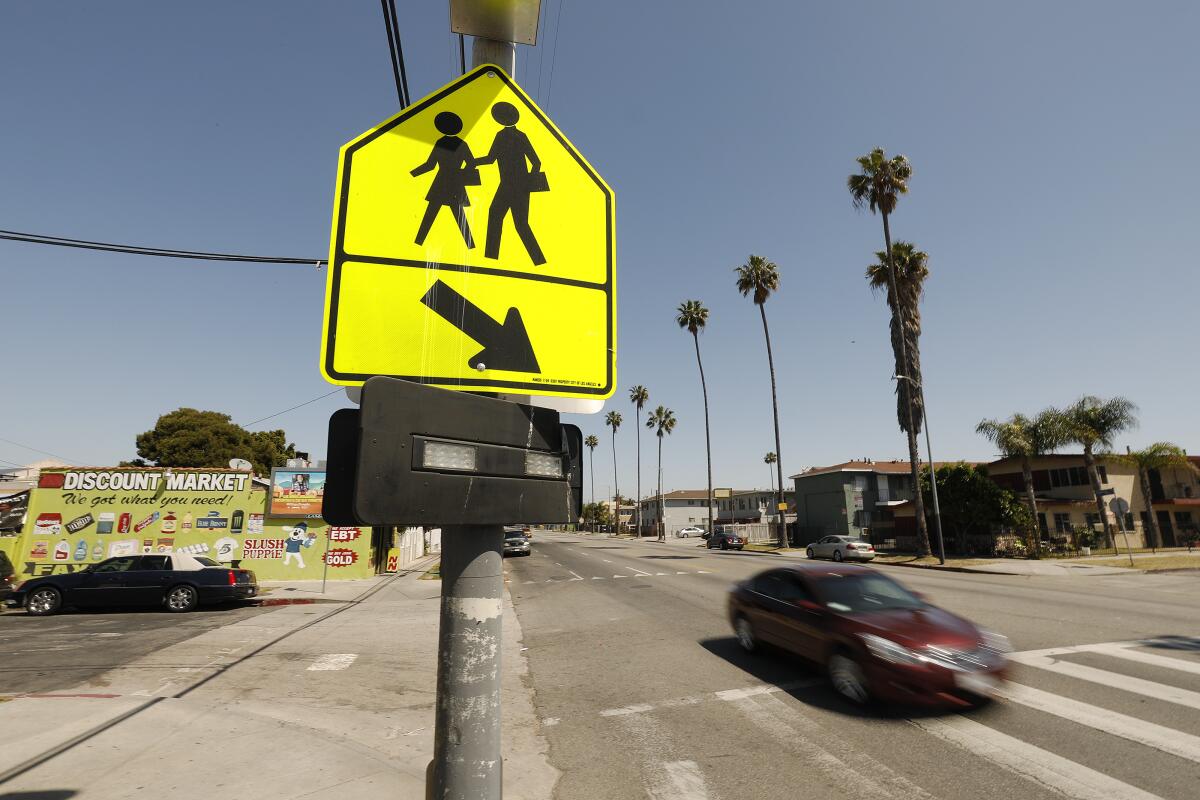Opinion: Speed cameras save lives. California is long overdue to try them

Speed is the single biggest factor in determining the severity of a car crash, and yet California has resisted the most obvious tool to slow down traffic: speed-enforcement cameras. Still, the state has learned a few lessons over the years from experiments with red-light cameras, and there’s now a bill in Sacramento that could deploy similar technology to lifesaving effect.
Without speed cameras, cities face an untenable choice: Let drivers flout traffic laws and allow vulnerable road users like pedestrians and cyclists to die, or increase enforcement by police — which fuels conflict and casualties. If anything, California is moving toward reducing traffic stops, which can be a pretext for harassing Black and Latino drivers.
The new legislation, introduced by Assemblymember Laura Friedman (D-Glendale), would legalize speed cameras for pilot programs in Los Angeles, San Jose, Oakland, Glendale, Long Beach and San Francisco, providing a way to step up enforcement of speed laws without police confrontation or human bias.
Speed-camera proposals in Sacramento in 2021 and 2022 died over concerns about privacy and equitable enforcement, and the revised legislation this year addresses those fears: Tickets would be issued to the person listed as the owner of the speeding vehicle, not to the driver, so no facial recognition would be involved — a point of concern for the American Civil Liberties Union. Cameras would be distributed fairly across those six cities to avoid disproportionately ticketing certain populations.
Police organizations also opposed the previous bills. One sponsor said the unions were concerned that the success of speed cameras would lead to reductions in police workforces. But that doesn’t seem likely. California has plenty of other problems for officers to pursue if speeding becomes less of a threat. More serious, time-sensitive crime makes more sense for officers to focus on.
Drivers would get plenty of notice to avoid incurring fines. Under the pilots proposed, there would be posted warning signs to notify drivers that they’re about to enter a zone that has speed cameras. The pilot would begin with a 30-day period educating drivers (but not issuing tickets), followed by a 60-day period in which automated warnings are issued but no tickets. After that, first violations will result in nominal fines, increasing for repeated violations.
More than a decade ago, drivers and politicians widely faulted red-light cameras in Southern California for excessive fines. Some cities were accused of issuing tickets for right turns at red lights not to improve safety but to raise revenue. The L.A. City Council nixed red-light cameras in 2011, while they still remain in operation in surrounding cities like Beverly Hills and Culver City.
Another key change is where the revenue will go. Unlike with red-light cameras, revenue from the speed camera pilot program would not go to cities’ general funds but toward roadway improvements that make streets safer for all and reduce the likelihood of speeding in the first place.
If Sacramento allows these pilot programs, we should see an almost immediate safety improvement. Indeed, if drivers know that they’re likely to be caught by an automated speed camera, they’ll be less inclined to speed in the first place. Slowing down will save lives.
According to the National Highway Traffic Safety Administration, when struck by a vehicle traveling at 20 mph, 95% of pedestrians survive. At 30 mph, 60% survive; at 40 mph, 20%. At speeds above 50 mph, the survival rate is 0%.
Yet every arterial in Los Angeles has at least a 35-mph posted speed limit, with drivers routinely reaching 45 mph or faster. Even a recent state action that allowed Los Angeles to lower speed limits didn’t make much of a dent; the main result was the limit returning to 35 mph on some streets where it had crept higher.
It’s no wonder, then, that traffic fatalities soared to a two-decade high in Los Angeles in 2022, especially in light of massively large trucks and SUVs currently popular on our streets. No one should have to fear for their life while crossing a street or riding a bike in Los Angeles — a city where a pedestrian is killed once every three days.
Other cities have shown that speed cameras help address this problem. Automated enforcement is already a reality in Chicago, New York City, Philadelphia, Portland, Ore., Seattle and Washington. A recent study from Chicago’s Department of Transportation found that cameras decreased the risk of serious injury or death from crashes involving speeding.
Progressive California is overdue to adopt automated solutions with proven safety benefits for all who use our roads. Automated speed cameras will save lives in Los Angeles.
Michael Schneider is the founder of Streets for All.
More to Read
A cure for the common opinion
Get thought-provoking perspectives with our weekly newsletter.
You may occasionally receive promotional content from the Los Angeles Times.










